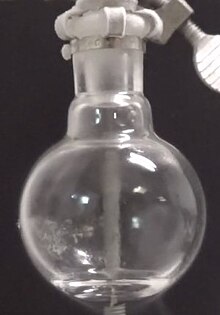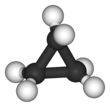Cyclopropane
| |||
| |||

| |||
| Names | |||
|---|---|---|---|
| Preferred IUPAC name
Cyclopropane[2] | |||
| Identifiers | |||
3D model (
JSmol ) |
|||
| ChEBI | |||
| ChEMBL | |||
| ChemSpider | |||
ECHA InfoCard
|
100.000.771 | ||
| KEGG | |||
PubChem CID
|
|||
| UNII | |||
| UN number | 1027 | ||
CompTox Dashboard (EPA)
|
|||
| |||
| |||
| Properties | |||
| C3H6 | |||
| Molar mass | 42.08 g/mol | ||
| Appearance | Colorless gas | ||
| Odor | Sweet, ethereal | ||
| Density | 1.879 g/L (1 atm, 0 °C) 680 g/L (liquid) | ||
| Melting point | −128 °C (−198 °F; 145 K) | ||
| Boiling point | −32.9 °C (−27.2 °F; 240.2 K) | ||
| 502 mg/L | |||
| Vapor pressure | 640 kPa (20 °C) 1350 kPa (50 °C) | ||
| Acidity (pKa) | ~46 | ||
| -39.9·10−6 cm3/mol | |||
| Hazards | |||
| Occupational safety and health (OHS/OSH): | |||
Main hazards
|
Highly flammable Asphyxiant | ||
| GHS labelling: | |||
 
| |||
| Danger | |||
| NFPA 704 (fire diamond) | |||
| 495 °C (923 °F; 768 K) | |||
Explosive limits
|
2.4 % (lower) 10.4 % (upper) | ||
| Safety data sheet (SDS) | Air Liquide | ||
Except where otherwise noted, data are given for materials in their standard state (at 25 °C [77 °F], 100 kPa).
| |||
Cyclopropane is the cycloalkane with the molecular formula (CH2)3, consisting of three methylene groups (CH2) linked to each other to form a triangular ring. The small size of the ring creates substantial ring strain in the structure. Cyclopropane itself is mainly of theoretical interest but many of its derivatives - cyclopropanes - are of commercial or biological significance.[3]
Cyclopropane was used as a clinical inhalational anesthetic from the 1930s through the 1980s. The substance's high flammability poses a risk of fire and explosions in operating rooms due to its tendency to accumulate in confined spaces, as its density is higher than that of air.
History
Cyclopropane was discovered in 1881 by August Freund, who also proposed the correct structure for the substance in his first paper.[4] Freund treated 1,3-dibromopropane with sodium, causing an intramolecular Wurtz reaction leading directly to cyclopropane.[5] The yield of the reaction was improved by Gustavson in 1887 with the use of zinc instead of sodium.[6] Cyclopropane had no commercial application until Henderson and Lucas discovered its anaesthetic properties in 1929;[7] industrial production had begun by 1936.[8] In modern anaesthetic practice, it has been superseded by other agents.
Anaesthesia
Cyclopropane was introduced into clinical use by the American anaesthetist Ralph Waters who used a closed system with carbon dioxide absorption to conserve this then-costly agent. Cyclopropane is a relatively potent, non-irritating and sweet smelling agent with a
Pharmacology
Cyclopropane is inactive at the GABAA and glycine receptors, and instead acts as an NMDA receptor antagonist.[12][13] It also inhibits the AMPA receptor and nicotinic acetylcholine receptors, and activates certain K2P channels.[12][13][14]
Structure and bonding

The triangular structure of cyclopropane requires the
Despite their shortness, the C-C bonds in cyclopropane are weakened by 34 kcal/mol vs ordinary C-C bonds. In addition to ring strain, the molecule also has torsional strain due to the eclipsed conformation of its hydrogen atoms. The C-H bonds in cyclopropane are stronger than ordinary C-H bonds as reflected by NMR coupling constants.
Bonding between the carbon centres is generally described in terms of bent bonds.[17] In this model the carbon-carbon bonds are bent outwards so that the inter-orbital angle is 104°.
The unusual structural properties of cyclopropane have spawned many theoretical discussions. One theory invokes σ-aromaticity: the stabilization afforded by delocalization of the six electrons of cyclopropane's three C-C σ bonds to explain why the strain of cyclopropane is "only" 27.6 kcal/mol as compared to cyclobutane (26.2 kcal/mol) with cyclohexane as reference with Estr=0 kcal/mol,[18][19][20] in contrast to the usual π aromaticity, that, for example, has a highly stabilizing effect in benzene. Other studies do not support the role of σ-aromaticity in cyclopropane and the existence of an induced ring current; such studies provide an alternative explanation for the energetic stabilization and abnormal magnetic behaviour of cyclopropane.[21]
Synthesis
Cyclopropane was first produced via a
- BrCH2CH2CH2Br + 2 Na → (CH2)3 + 2 NaBr
The preparation of cyclopropane rings is referred to as cyclopropanation.
Reactions
Owing to the increased π-character of its C-C bonds, cyclopropane is often assumed to add bromine to give 1,3-dibromopropane, but this reaction proceeds poorly.
Cyclopropane and its derivatives can
Safety
Cyclopropane is highly flammable. However, despite its strain energy it does not exhibit explosive behavior substantially different from other alkanes.
See also
- Tetrahedrane contains four fused cyclopropane rings that form the faces of a tetrahedron
- Propellane contains three cyclopropane rings that share a single central carbon-carbon bond.
- Cyclopropene
- Methylenecyclopropane
References
- ^ Merck Index, 11th Edition, 2755.
- ISBN 978-0-85404-182-4.
- PMID 11433485.
- ^ .
- S2CID 197767176.
- .
- PMID 20317448.
- .
- PMID 4378907.
- PMID 15426685.
- PMID 8024925.
- ^ ISBN 978-0-323-03707-5.
- ^ ISBN 978-1-60761-463-0.
- S2CID 21160239.[permanent dead link]
- .
- ISBN 978-3-319-22824-2.
- ^ Eric V. Anslyn and Dennis A. Dougherty. Modern Physical Organic Chemistry. 2006. pages 850-852
- ^ S. W. Benson, Thermochemical Kinetics, S. 273, J. Wiley & Sons, New York, London, Sydney, Toronto 1976
- .
- .
- PMID 19562784.
- ISBN 978-3527306732.
- .
- ISBN 0-471-85472-7






